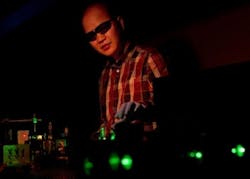Quantum-dot VCSELs can emit anywhere in the visible spectrum
Providence, RI and Watertown, MA--Researchers at Brown University and QD Vision are engineering a better form of colloidal quantum dots for use in quantum-dot lasers, which can be made to emit light anywhere in the visible spectrum.1 Helped along by a "glue" of aromatic ligands, the core/shell quantum dots adhere together in densely packed films.
The quantum-dot nanocrystals have an inner core of cadmium and selenium alloy and a coating of zinc, cadmium, and sulfur alloy (a CdSe/ZnCdS core/shell). As with any quantum dot, the size determines the emitting color.
Chemists at QD Vision synthesize the nanocrystals using a wet chemistry process that allows them to precisely vary the nanocrystal size by varying the production time. Size is all that needs to change to produce different laser light colors: 4.2 nm cores produce red light, 3.2 nm cores emit green light, and 2.5 nm cores emit blue.
“Today in order to create a laser display with arbitrary colors, from white to shades of pink or teal, you’d need these three separate material systems to come together in the form of three distinct lasers that in no way shape or form would have anything in common,” said Arto Nurmikko, a professor of engineering at Brown University. “Now enter a class of materials called semiconductor quantum dots.”
Core/shell structure is critical
The cladding and the nanocrystal structure are critical advances beyond previous attempts to make lasers with colloidal quantum dots, said lead author Cuong Dang, a senior research associate and nanophotonics laboratory manager in Nurmikko’s group at Brown. Because of their improved quantum-mechanical and electrical performance, he said, the coated pyramids require 10 times less peak energy and 1000 times less power to produce laser light than previous attempts at the technology.
To make a laser, Dang coats a square or other shape of glass with the viscous quantum-dot-containing liquid. When it evaporates, what’s left on the glass are several densely packed solid, highly ordered layers of the nanocrystals. This can be sandwiched between laser mirrors to create a vertical-cavity surface-emitting laser (VCSEL). The Brown-led team was the first to make a working VCSEL with colloidal quantum dots.
Reducing losses due to the Auger process
Faced with a high excited electronic state requirement and destructive crosstalk in a densely packed layer, previous groups have needed to pump their dots with a lot of power to push them past a higher threshold for producing light amplification, a core element of any laser. Pumping them intensely, however, gives rise to another problem: an excess of excited electronic states called excitons. When there are too many of these excitons among the quantum dots, energy that could be producing light is instead more likely to be lost as heat, mostly through a phenomenon known as the Auger process.
The nanocrystals’ structure and outer cladding reduces destructive crosstalk and lowers the energy needed to get the quantum dots to emit. That reduces the energy required to pump the quantum dot laser and significantly reduces the likelihood of exceeding the level of excitons at which the Auger process drains energy away. In addition, a benefit of the new approach’s structure is that the dots can act more quickly, releasing light before Auger process can get started, even in the rare cases when it still does start.
REFERENCE:
1. Cuong Dang et al., Nature Nanotechnology (2012); doi:10.1038/nnano.2012.61.

John Wallace | Senior Technical Editor (1998-2022)
John Wallace was with Laser Focus World for nearly 25 years, retiring in late June 2022. He obtained a bachelor's degree in mechanical engineering and physics at Rutgers University and a master's in optical engineering at the University of Rochester. Before becoming an editor, John worked as an engineer at RCA, Exxon, Eastman Kodak, and GCA Corporation.
